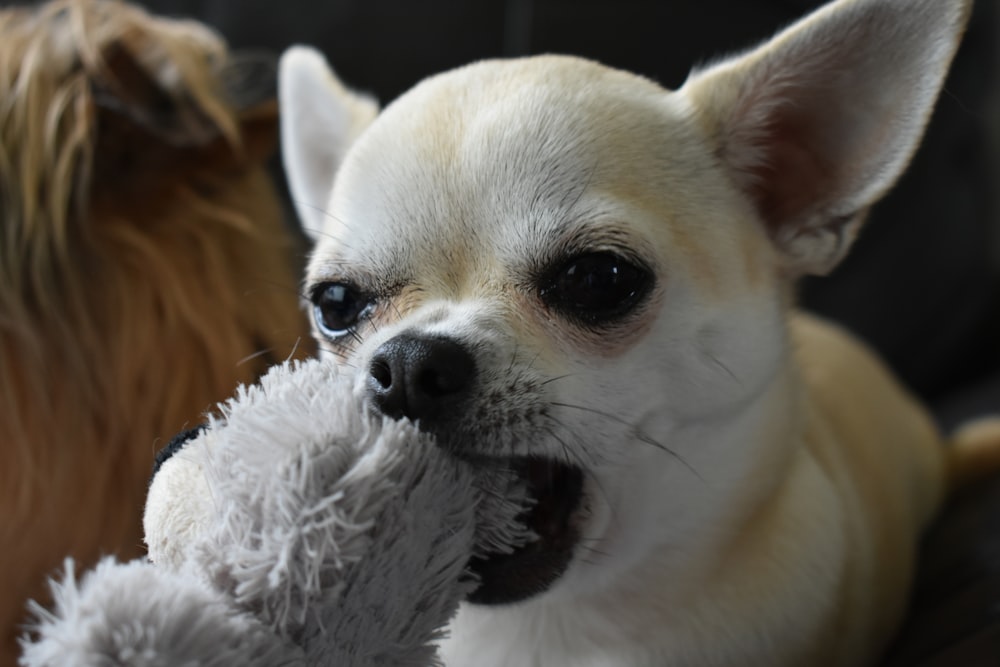We’ve all seen the situation: you bring home a new puppy, only to later find they have chewed up your favorite pair of shoes! It’s no secret that puppies explore their world with their mouths, but much of their chewing behavior can be attributed to your puppy teething. Puppy teething is a natural process puppies undergo as they lose their puppy teeth and grow their bright white adult teeth. We can help our puppies with the discomfort associated with teething by using some of the following tips.

When Do Puppies Teethe?
Puppies begin losing baby teeth, also called deciduous teeth, at an individual rate. Generally, most puppies lose their first baby teeth during their third month of life. The first teeth to fall out are the incisors, the small teeth at the front of your puppy’s mouth.
Teething then moves from the front of the mouth to the back. The canines fall out after the incisors, followed by the premolars and the molars. Once your puppy has reached between 6 and 8 months of age, your puppy should have all 42 adult teeth.
Though this seems like a long span, your puppy likely will not experience teething symptoms this entire time. Actual teething symptoms, such as excessive chewing, usually occur for about two weeks as the canines, premolars, and molars are growing in.

Signs of A Teething Puppy
Losing teeth isn’t the only sign that your puppy is teething. Here are a few more indications that your puppy may be experiencing oral discomfort:
- loss of appetite
- upset tummy
- soft stools
- low-grade fever
If your puppy experiences vomiting, prolonged diarrhea, or other signs of illness, consult your veterinarian. You should also check periodically for retained puppy teeth. Retained puppy teeth are teeth that do not fall out and are alongside the growing adult teeth. If this occurs, you should contact your veterinarian immediately, as the presence of the baby tooth could damage the growing adult tooth.
Start Teething Training Young
Your dog’s puppyhood is the perfect time to begin training. Habits you establish now will affect your dog’s behavior well into adulthood. If your puppy picks up undesirable chewing behaviors during teething, they may retain those unfortunate chewing habits as adults.
The best way to mitigate this chewing behavior early on is to be clear with your puppy about what is and is not acceptable to chew on. Do your best to limit your puppy’s access to your personal items. Puppies will seek items that smell like you such as shoes, clothing, remotes, cell phones, sunglasses, hats, etc. Put these items away or out of reach, and consider using baby gates to limit what areas of your home your puppy has access to. If your puppy picks up something he or she shouldn’t have, quickly remove it and replace it with something your puppy is allowed to chew.

Provide Chew Toys For Puppy Teething
Chewing alleviates some of the pain and discomfort your puppy experiences while teething. Providing chew toys is an excellent alternative for your puppy to chew on than your best shoes. If your puppy is not initially interested in their chew toys, try smearing a small amount of peanut butter onto the toy to better engage them.
Rawhide
Rawhides are hide or animal skin that has not been tanned. These are hard bones that your dog can chew on.
Dental Chews
Dental chews such as Greenies are great for dental care and teething puppies too. For a great list of available dental chews, check out this article.
Hard Plastic Bones
Hard plastic bones such as Nylabone and other dogs chews may help with your puppy’s teething and do not have some of the same risks associated with rawhides.

Practice Gum Massages For Puppy Teething
Gum massages are a great way to alleviate some of the discomforts your teething puppy is dealing with. Simply gather your puppy in your lap and run your fingers slowly, gently, and methodically over their gums. This comforts your puppy and provides some relief to their aching mouths.
Fingertip Toothbrush
Consider purchasing a fingertip toothbrush to give your puppy a gum massage. This not only provides some relief but also conditions your puppy to accept daily teeth brushings throughout their life. Dental care is not just important during puppyhood and teething, but for the duration of your dog’s life.
Frozen Treats For Puppy Teething
In addition to chew toys and gum massages, you can also give your puppy frozen treats to ease their mouth pain. One popular choice is freezing cubes of chicken stock. The chicken stock gets your puppy interested in chewing, and the ice reduces inflammation and pain in the gums. Another option is to freeze a food toy with food inside. For example, take a Kong toy and fill it with peanut butter, banana, or pureed yam.
Ease Your Puppy’s Teething Woes
We all want what’s best for our furbabies, especially when they are in pain. Though teething is a short period of time in our puppy’s life, we want to make it as painless as possible. Use the tips listed above to ease your puppy’s transition into adult teeth. Helping your puppy through this tough time will bring you both closer together and begin his life-long training to become a well-rounded and well-behaved pup.

